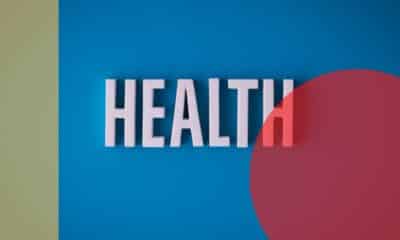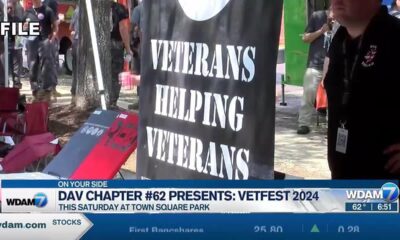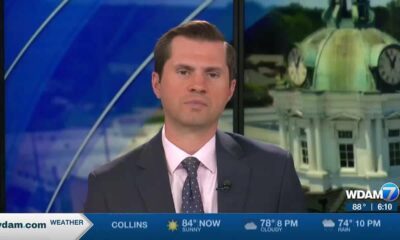Kaiser Health News
Montana Clinics Chip Away at Refugees’ Obstacles to Dental Care
by Erica Zurek
Thu, 15 Jun 2023 09:00:00 +0000
MISSOULA, Mont. — Yu Yu Htwe had never had dental problems, so she was surprised when a dentist told her she had three cavities at her first appointment in this small city in western Montana.
Htwe, 38, is from Myanmar and worked as an OB-GYN there until a military coup overthrew the government in February 2021. Alongside other medical workers, she participated in a civil disobedience movement against the military, and, fearing reprisal, fled the country with her husband and young daughter.
Htwe and her family spent six months in Thailand before they resettled in Missoula as refugees early last year. That move around the globe took less time than the eight months she waited to get a dental appointment after arriving in Montana.
“In my country, dental care is not like it is here,” said Htwe, who is now a community health worker at Partnership Health Center in Missoula. “Here we need to wait for dental care. In Myanmar, it's not like that. We can go at any time when we need a consultation or something.”
Refugee advocates in Montana hear stories like Htwe's often. And these stories are similar to what low-income people can contend with across the U.S. Long wait times for dental appointments, high costs, and finding dentists willing to take new Medicaid patients make access to dental care difficult.
Refugees in the U.S. encounter additional challenges getting dental care because of cultural differences, and language and transportation issues, but their specific circumstances vary widely depending on where they resettle, and if the state offers dental coverage for refugees.
The flow of refugees admitted to the U.S. is growing since the Biden administration set the annual cap for the fiscal year that began in October to 125,000, up from 18,000 in 2020. More than 24,000 refugees arrived between October and April, 83 of whom resettled in Montana. The state and country are on pace to welcome more refugees than last year.
“It's a health equity issue when patients have an array of barriers to getting care,” said Jane Grover, a dentist and the director of the Council on Access, Prevention, and Interprofessional Relations for the American Dental Association.
She added that dental pain complicates a person's ability to eat, work, and do daily tasks. When oral health is suboptimal, the risk for gum and periodontal disease increases. That can then lead to other health issues like heart disease and diabetes.
“Often, refugees come to us with some or very little previous dental care,” said Bonnie Medlin, health and education programs coordinator for the International Rescue Committee in Missoula.
Refugees spend an average of about 10 years in refugee camps before resettlement, and those camps may or may not have dental services, said Medlin.
When refugees arrive in Montana, they are enrolled in the state's Medicaid program and are eligible for most medically necessary dental services like exams, teeth cleanings, and X-rays. State Medicaid programs decide the level of adult dental benefits to offer, and Montana is among 18 states, plus Washington, D.C., that provide extensive coverage. But having health coverage doesn't guarantee a person can see a dentist quickly or at all.
Montana health department spokesperson Jon Ebelt said private practice dentists are not required to have a certain percentage of their patients covered by Medicaid. They can choose whether to accept Medicaid or any other insurance.
A federal Refugee Medical Assistance program run by the Department of Health and Human Services provides short-term medical coverage to refugees who are not eligible for Medicaid, but only emergency dental treatments are covered.
In Missoula, three private dental clinics frequently work with refugees who are on Medicaid. One is strictly a pediatric dental office, however, and the other two perform only surgical procedures.
States set Medicaid reimbursement rates for dental care and Montana's rates rank above the national average. Despite this, the numbers don't always add up. “Dentists in private practice want to help and accept Medicaid patients when they can, but the margin just makes it impossible for them,” said Lara Salazar, CEO of Partnership Health Center, a community health clinic based in Missoula.
“We see patients regardless of their socioeconomic status, offer a sliding scale fee, and accept all insurance for the 65,000 visits we get across our clinics per year,” said Salazar.
PHC's dental clinics provide comprehensive and emergency dental care for adults and children and see around 975 patients a month. Most mornings 10 to 20 people line up for urgent, same-day appointments at the center's downtown clinic. Some of the patients needing urgent dental care are part of Missoula's refugee population.
“People are dealing with abscesses, root canals and suddenly they're in a dental chair and things are happening. It's especially scary when they haven't been to a dentist before,” said Helen Maas, a senior community health specialist who works on PHC's refugee-focused health team with Htwe. “Trying to explain how the health care system works gets very complicated,” she said.
Federal and state laws require providers serving Medicaid patients to offer interpretation services when needed, but Medicaid reimbursement doesn't cover all the costs, said Maas. “I know this is an issue for providers in town and a reason they are not able to accommodate everyone.”
Patients and providers at PHC connect with medically certified interpreters via phone and video chat. Maas said the translation service is great, but sometimes it can take up to an hour to find an appropriate interpreter for less common languages, like Dari and Pashto.
According to Maas, limited transportation is an additional obstacle for refugee families and can make getting to scheduled appointments particularly hard once they start working.
Another challenge is appointment wait times. New patient appointments for refugee children happen soon after arrival. But adults on Medicaid often wait up to nine months for an initial dental exam at PHC or another clinic in Missoula unless they are in acute pain that prohibits eating or causes major health concerns. “Timing depends on if providers outside of Partnership are accepting new Medicaid patients, and many are not,” said Maas.
To help accommodate the need, some dentists in the community donate services to refugee patients. Maas hopes to see more of this in the future.
In the meantime, outcomes look promising for refugees like Htwe who needed dental care after resettlement. “When I went to my appointment, the dentist set up a long-term plan for my teeth,” she said. “I've had two cleaning appointments and I now have a habit of flossing.”
By: Erica Zurek
Title: Montana Clinics Chip Away at Refugees' Obstacles to Dental Care
Sourced From: kffhealthnews.org/news/article/montana-refugees-dental-care-barriers/
Published Date: Thu, 15 Jun 2023 09:00:00 +0000
Did you miss our previous article…
https://www.biloxinewsevents.com/foster-kids-in-casino-hotels-it-happened-in-rural-nevada-amid-widespread-foster-home-shortages/
Kaiser Health News
Watch: John Oliver Dishes on KFF Health News’ Opioid Settlements Series
Fri, 17 May 2024 09:00:00 +0000
Opioid manufacturers, distributors, and retailers are paying tens of billions of dollars in restitution to settle lawsuits related to their role in the nation's overdose epidemic. A recent broadcast of “Last Week Tonight With John Oliver” examined how that money is being spent by state and local governments across the United States.
The segment featured reporting from the KFF Health News series “Payback: Tracking the Opioid Settlement Cash.” You can learn more about the issue and read our collection of articles by Aneri Pattani here.
——————————
Title: Watch: John Oliver Dishes on KFF Health News' Opioid Settlements Series
Sourced From: kffhealthnews.org/news/article/watch-john-oliver-kff-health-news-payback-opioid-settlements-series/
Published Date: Fri, 17 May 2024 09:00:00 +0000
Kaiser Health News
KFF Health News’ ‘What the Health?’: Bird Flu Lands as the Next Public Health Challenge
Thu, 16 May 2024 18:30:00 +0000
The Host
Julie Rovner
KFF Health News
Julie Rovner is chief Washington correspondent and host of KFF Health News' weekly health policy news podcast, “What the Health?” A noted expert on health policy issues, Julie is the author of the critically praised reference book “Health Care Politics and Policy A to Z,” now in its third edition.
Public health officials are watching with concern since a strain of bird flu spread to dairy cows in at least nine states, and to at least one dairy worker. But in the wake of covid-19, many farmers are loath to let in health authorities for testing.
Meanwhile, another large health company — the Catholic hospital chain Ascension — has been targeted by a cyberattack, leading to serious problems at some facilities.
This week's panelists are Julie Rovner of KFF Health News, Rachel Cohrs Zhang of Stat, Alice Miranda Ollstein of Politico, and Sandhya Raman of CQ Roll Call.
Panelists
Rachel Cohrs Zhang
Stat News
Alice Miranda Ollstein
Politico
Sandhya Raman
CQ Roll Call
Among the takeaways from this week's episode:
- Stumbles in the early response to bird flu bear an uncomfortable resemblance to the early days of covid, including the troubles protecting workers who could be exposed to the disease. Notably, the Department of Agriculture benefited from millions in covid relief funds designed to strengthen disease surveillance.
- Congress is working to extend coverage of telehealth care; the question is, how to pay for it? Lawmakers appear to have settled on a two-year agreement, though more on the extension — including how much it will cost — remains unknown.
- Speaking of telehealth, a new report shows about 20% of medication abortions are supervised via telehealth care. State-level restrictions are forcing those in need of abortion care to turn to options farther from home.
- And new reporting on Medicaid illuminates the number of people falling through the cracks of the government health system for low-income and disabled Americans — including how insurance companies benefit from individuals' confusion over whether they have Medicaid coverage at all.
Also this week, Rovner interviews Atul Grover of the Association of American Medical Colleges about its recent analysis showing that graduating medical students are avoiding training in states with abortion bans and major restrictions.
Plus, for “extra credit,” the panelists suggest health policy stories they read this week that they think you should read, too:
Julie Rovner: NPR's “Why Writing by Hand Beats Typing for Thinking and Learning,” by Jonathan Lambert.
Alice Miranda Ollstein: Time's “‘I Don't Have Faith in Doctors Anymore.' Women Say They Were Pressured Into Long-Term Birth Control,” by Alana Semuels.
Rachel Cohrs Zhang: Stat's “After Decades Fighting Big Tobacco, Cliff Douglas Now Leads a Foundation Funded by His Former Adversaries,” by Nicholas Florko.
Sandhya Raman: The Baltimore Banner's “People With Severe Mental Illness Are Stuck in Jail. Montgomery County Is the Epicenter of the Problem,” by Ben Conarck.
Also mentioned on this week's podcast:
- Stat's “My Rendezvous With the Raw Milk Black Market: Quick, Easy, and Unchecked by the FDA,” by Nicholas Florko.
- The Stamford Advocate's “Dan Haar: Hackers Stole a Disabled CT Couple's SNAP Food Aid. Now They're Out $1,373,” by Dan Haar.
- WKRN's “‘Chaos': Nurses, Visitors Describe Conditions Inside Ascension Hospitals After Cyberattack,” by Stephanie Langston.
- KFF Health News' “Medicaid ‘Unwinding' Decried as Biased Against Disabled People,” by Daniel Chang.
- KFF Health News' “Why Medicaid's ‘Undercount' Problem Counts,” by Phil Galewitz.
Credits
Francis Ying
Audio producer
Emmarie Huetteman
Editor
To hear all our podcasts, click here.
And subscribe to KFF Health News' “What the Health?” on Spotify, Apple Podcasts, Pocket Casts, or wherever you listen to podcasts.
——————————
Title: KFF Health News' ‘What the Health?': Bird Flu Lands as the Next Public Health Challenge
Sourced From: kffhealthnews.org/news/podcast/what-the-health-347-bird-flu-next-public-health-challenge-may-16-2024/
Published Date: Thu, 16 May 2024 18:30:00 +0000
Kaiser Health News
California’s $12 Billion Medicaid Makeover Banks on Nonprofits’ Buy-In
Angela Hart
Thu, 16 May 2024 09:00:00 +0000
TURLOCK, Calif. — For much of his young life, Jorge Sanchez regularly gasped for air, at times coughing so violently that he'd almost throw up. His mother whisked him to the emergency room late at night and slept with him to make sure he didn't stop breathing.
“He's had these problems since he was born, and I couldn't figure out what was triggering his asthma,” Fabiola Sandoval said of her son, Jorge, now 4. “It's so hard when your child is hurting. I was willing to try anything.”
In January, community health workers visited Sandoval's home in Turlock, a city in California's Central Valley where dust from fruit and nut orchards billows through the air. They scoured Sandoval's home for hazards and explained that harsh cleaning products, air fresheners, and airborne dust and pesticides can trigger an asthma attack.
The team also provided Sandoval with air purifiers, a special vacuum cleaner that can suck dust out of the air, hypoallergenic mattress covers, and a humidity sensor — goods that retail for hundreds of dollars. Within a few months, Jorge was breathing easier and was able to run and play outside.
The in-home consultation and supplies were paid for by Medi-Cal, California's Medicaid health insurance program for low-income residents. Gov. Gavin Newsom is spearheading an ambitious $12 billion experiment to transform Medi-Cal into both a health insurer and a social services provider, one that relies not only on doctors and nurses, but also community health workers and nonprofit groups that offer dozens of services, including delivering healthy meals and helping homeless people pay for housing.
These groups are redefining health care in California as they compete with businesses for a share of the money, and become a new arm of the sprawling Medi-Cal bureaucracy that serves nearly 15 million low-income residents on an annual budget of $158 billion.
But worker shortages, negotiations with health insurance companies, and learning to navigate complex billing and technology systems have hamstrung the community groups' ability to deliver the new services: Now into the third year of the ambitious five-year experiment, only a small fraction of eligible patients have received benefits.
“This is still so new, and everyone is just overwhelmed at this point, so it's slow-going,” said Kevin Hamilton, a senior director at the Central California Asthma Collaborative.
The collaborative has served about 3,650 patients, including Sandoval, in eight counties since early 2022, he said. It has years of experience with Medi-Cal patients in the Central Valley and has received about $1.5 million of the new initiative's money.
By contrast, CalOptima Health, Orange County's primary Medi-Cal insurer, is new to offering asthma benefits and has signed up 58 patients so far.
“Asthma services are so difficult to get going” because the nonprofit infrastructure for these services is virtually nonexistent, said Kelly Bruno-Nelson, CalOptima's executive director for Medi-Cal. “We need more community-based organizations on board because they're the ones who can serve a population that nobody wants to deal with.”
Newsom, a Democrat in his second term, says his signature health care initiative, known as CalAIM, seeks to reduce the cost of caring for the state's sickest and most vulnerable patients, including homeless Californians, foster children, former inmates, and people battling addiction disorders.
In addition to in-home asthma remediation, CalAIM offers 13 broad categories of social services, plus a benefit connecting eligible patients with one-on-one care managers to help them obtain anything they need to get healthier, from grocery shopping to finding a job.
The 25 managed-care insurance companies participating in Medi-Cal can choose which services they offer, and contract with community groups to provide them. Insurers have hammered out about 4,300 large and small contracts with nonprofits and businesses.
So far, about 103,000 Medi-Cal patients have received CalAIM services and roughly 160,000 have been assigned personal care managers, according to state data, a sliver of the hundreds of thousands of patients who likely qualify.
“We're all new to health care, and a lot of this is such a foreign concept,” said Helena Lopez, executive director of A Greater Hope, a nonprofit organization providing social services in Riverside and San Bernardino counties, such as handing out baseball cleats to children to help them be active.
Tiffany Sickler runs Koinonia Family Services, which offers California foster children mental health and other types of care, and even helped a patient pay off parking tickets. But the program is struggling on a shoestring budget.
“If you want to do this, you have to learn all these new systems. It's been a huge learning curve, and very time-consuming and frustrating, especially without adequate funding,” she said.
Brandon Richards, a Newsom spokesperson, defended CalAIM, saying that it was “on the cutting edge of health care” and that the state was working to increase “awareness of these new services and support.”
For nonprofits and businesses, CalAIM is a money-making opportunity — one that top state health officials hope to make permanent. Health insurers, which receive hefty payments from the state to serve more people and offer new services, share a portion with service providers.
In some places, community groups are competing with national corporations for the new funding, such as Mom's Meals, an Iowa-based company that delivers prepared meals across the United States.
Mom's Meals has an advantage over neighborhood nonprofit groups because it has long served seniors on Medicare and was able to immediately start offering the CalAIM benefit of home-delivered meals for patients with chronic diseases. But even Mom's Meals isn't reaching everyone who qualifies, because doctors and patients don't always know it's an option, said Catherine Macpherson, the company's chief nutrition officer.
“Utilization is not as high as it should be yet,” she said. “But we were well positioned, because we already had departments to do billing and contracting with health care.”
Middleman companies also have their eye on the billions of CalAIM dollars and are popping up to assist small organizations to go up against established ones like Mom's Meals. For instance, the New York-based Nonprofit Finance Fund is advising homeless service providers how to get more contracts and expand benefits.
Full Circle Health Network, with 70 member organizations, is helping smaller nonprofit groups develop and deliver services primarily for families and foster children. Full Circle has signed a deal with Kaiser Permanente, allowing the health care giant to access its network of community groups.
“We're allowing organizations to launch these benefits much faster than they've been able to do and to reach more vulnerable people,” said Camille Schraeder, chief executive of Full Circle. “Many of these are grassroots organizations that have the trust and expertise on the ground, but they're new to health care.”
One of the biggest challenges community groups face is hiring workers, who are key to finding eligible patients and persuading them to participate.
Kathryn Phillips, a workforce expert at the California Health Care Foundation, said there isn't enough seed money for community groups to hire workers and pay for new technology platforms. “They bring the trust that is needed, the cultural competency, the diversity of languages,” she said. “But there needs to be more funding and reimbursement to build this workforce.”
Health insurers say they are trying to increase the workforce. For instance, L.A. Care Health Plan, the largest Medi-Cal insurer in California, has given $66 million to community organizations for hiring and other CalAIM needs, said Sameer Amin, the group's chief medical officer.
“They don't have the staffing to do all this stuff, so we're helping with that all while teaching them how to build up their health care infrastructure,” he said. “Everyone wants a win, but this isn't going to be successful overnight.”
In the Central Valley, Jorge Sanchez is one of the lucky early beneficiaries of CalAIM.
His mother credits the trust she established with community health workers, who spent many hours over multiple visits to teach her how to control her son's asthma.
“I used to love cleaning with bleach” but learned it can trigger breathing problems, Sandoval said.
Since she implemented the health workers' recommendations, Sandoval has been able to let Jorge sleep alone at night for the first time in four years.
“Having this program and all the things available is amazing,” said Sandoval, as she pointed to the dirty dust cup in her new vacuum cleaner. “Now my son doesn't have as many asthma attacks and he can run around and be a normal kid.”
This article was produced by KFF Health News, which publishes California Healthline, an editorially independent service of the California Health Care Foundation.
——————————
By: Angela Hart
Title: California's $12 Billion Medicaid Makeover Banks on Nonprofits' Buy-In
Sourced From: kffhealthnews.org/news/article/newsom-medicaid-12-billion-dollar-makeover-nonprofits-bureacracy-calaim/
Published Date: Thu, 16 May 2024 09:00:00 +0000
-
SuperTalk FM4 days ago
Martin Lawrence making 3 stops in Mississippi on comedy tour
-
Our Mississippi Home3 days ago
Beat the Heat with Mississippi’s Best Waterparks
-
Mississippi Today7 days ago
Lawmakers may have to return to Capitol May 14 to override Gov. Tate Reeves’ potential vetoes
-
Our Mississippi Home4 days ago
Charlie’s U-Pik: Opening Soon for the Summer Season
-
Mississippi News Video6 days ago
Local dentists offer free dental care in Amory
-
Kaiser Health News3 days ago
Medicaid ‘Unwinding’ Decried as Biased Against Disabled People
-
Mississippi News Video2 days ago
Jackson has a gang problem
-
Mississippi News7 days ago
Bond set for West Point couple accused of killing their child




























![HIGH SCHOOL SOFTBALL: Vancleave @ East Central (5/9/2024) [5A Playoffs, South State]](https://www.biloxinewsevents.com/wp-content/uploads/2024/05/1715460379_maxresdefault-80x80.jpg)







